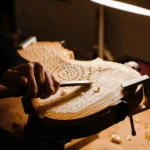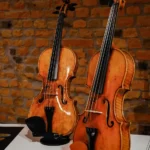How Do You Take Care of a Violin?
Back to BlogHow Do You Take Care of a Violin?
Wondering how do you take care of a violin to ensure its longevity and preserve its exquisite sound quality? Your violin is not just an instrument; it’s a work of art and a musical companion that deserves proper care and attention. In this comprehensive guide, we’ll walk you through essential insights and valuable care tips on effectively maintaining your violin so it remains in peak condition for years to come.
From daily care routines to handling and storage techniques, we’ll cover all aspects of violin maintenance. Whether you’re a seasoned player or just starting, learning to care for your instrument properly will enhance its performance and enhance its enduring beauty. Let’s dive into the world of violin care and discover the practices that will keep your violin singing with brilliance and warmth every time you play.
Daily Violin Care Routine
Maintaining a consistent daily instrument care routine is crucial to preserving your violin’s pristine condition and sound quality. Taking a few simple steps after each playing session can prevent dirt, rosin buildup, and oils from your skin from affecting the instrument’s finish characteristics.
Start by using a soft, lint-free cloth to gently wipe down your violin, and we do not advise using any cleaning products, just the dry cloth. This helps remove accumulated rosin dust and prevents it from settling on the instrument’s surface. Carefully clean the strings and the fingerboard to ensure optimal sound quality during your next practice or performance. The buildup of rosin dust can affect the strings’ vibration, decreasing resonance and projection.
Your violin bow also requires attention in your daily care routine. After a playing session, delicately clean the bow hair with a soft cloth to remove excess rosin. Proper bow hair care is essential for maintaining the quality of sound produced while playing. Following these simple steps as part of your daily instrument care routine will contribute to your instrument’s long-term health and performance.
Environmental Factors
Your violin’s well-being is closely tied to the environment it resides in. Fluctuations in temperature and humidity can significantly impact your instrument’s condition, affecting its tone, structure, and overall playability. Protecting your violin from extreme conditions is essential for its longevity and performance.
Storing your instrument in a climate-controlled environment prevents cracks and other damage. The place you live matters, as humidity and temperature levels can vary. Awareness of the relative humidity, the amount of moisture in the air compared to its capacity at a given temperature, in the spaces where your instrument is kept is critical.
Weather changes can have various effects on your violin:
- Changes in Dimensions: Dry weather can cause the wood to contract, altering the height of the top, bridge, and neck, while high humidity can have the opposite effect.
- Seams and Cracks: Extended exposure to low humidity (below 30%) can lead to seams opening and cracks forming, particularly in vulnerable areas like the top.
- Sound Quality: Very dry environments produce a strident and harsh sound, whereas high humidity results in a weaker and sandier tone.
- Buzzing: Dry weather might lead to lower strings buzzing due to string tension changes.
How to prevent violin damage?
- High Humidity: If humidity is excessive, expose your instrument to sunlight for short periods, avoiding the hottest hours.
- Low Humidity: Use a humidifier designed for string instruments, like Dampit, to stabilize internal humidity.
- Monitor Violin Case Humidity: Check the humidity levels within your case. Moisten or dry the case fabric accordingly to maintain ideal humidity.
- Bow Care: The bow’s hair reacts to temperature and humidity changes. Limit exposure to extreme conditions to preserve its condition.
Maintain humidity levels at 50-60% to ensure your instrument’s optimal condition and sound quality. Regularly monitoring humidity levels will safeguard your violin from issues caused by fluctuating environmental conditions.
Violin Parts Care
The violin is a stringed instrument with several parts and accessories; the proper care of its individual parts is also essential for maintaining its structural integrity and optimal sound quality. This section covers crucial aspects to consider in caring for your instrument.
Bridge Care:
The bridge transmits vibrations from the strings to the violin’s body. To ensure its stability and prevent warping, maintain the bridge at a 90-degree angle. After each playing session, wipe off rosin dust from the strings and bridge. When adjusting the bridge, loosen the strings slightly to facilitate movement. Handle the bridge delicately, as stringed instruments are fragile.
Soundpost Correct Position:
The placement of the soundpost greatly influences your instrument’s tonal qualities. The soundpost should be straight, positioned below the bridge’s foot on the treble side, about 1.5 to 2mm behind the bridge, and 1.5mm into the bridge’s foot. To check its alignment, lay the instrument horizontally. The soundpost should stand upright like a column perpendicular to the top plate. Adjusting the soundpost can alter the sound’s brightness and focus, affecting the instrument’s overall character. Consult a luthier for adjustments to ensure optimal sound balance.
Violin Strings Maintenance:
Lubricate the string grooves on the bridge and upper nut with soft graphite (6B) to prolong string life, reduce tension, and protect these components. Set the violin string height according to your preference, considering higher strings often yield a brighter, louder sound. However, avoid excessive string height, which could lead to discomfort or buzzing. Regularly changing violin strings is essential to maintain sound quality and playability. Frequency varies based on usage and factors like rosin buildup, sweat, and string material. Professional musicians may change strings monthly, while more casual players might do so every 3 to 6 months.
Temperature Adjustment Trick:
In cases of extreme cold or insufficient warm-up time before performing, a secret used by soloists can be helpful. Gently rubbing the strings with a cloth warms them slightly, making the metal more flexible and responsive. This trick provides added elasticity and breadth to the sound, enhancing the instrument’s overall performance.
By following these handling and placement practices, you can prolong the life of your violin and ensure its consistent sound quality and playability.
Maintenance and Instrument Storage
Maintaining and properly storing your violin is crucial to preserving its condition and longevity. Select an appropriate violin case for safeguarding your instrument. A sturdy and well-padded case protects against physical impacts and fluctuations in temperature and humidity. Ensure the case is lined with a soft material to prevent scratching the violin’s finish. A hygrometer and humidifier within the case can help maintain optimal humidity levels.
Store your violin in its case when not in use to shield it from environmental factors. Keep the case in a cool, dry place and away from direct sunlight, as extreme temperatures and UV rays can harm the instrument. Ensure the violin is securely fastened within the case to prevent it from shifting during movement.
Pay attention to your calendar for regular checkups and repairs. Professional maintenance is essential to address potential issues and maintain your violin’s peak performance. Regularly scheduling visits to a skilled luthier is a prudent practice. A luthier can identify subtle changes in your instrument’s condition that may affect its sound quality and playability.
By prioritizing proper maintenance storage and seeking professional expertise, you ensure that your violin continues to serve as a source of joy and musical expression for years to come.
Violin Accessories Care
Caring for your violin goes beyond just the instrument itself – it extends to the accessories that play a crucial role in its performance. Proper maintenance of violin accessories is essential for preserving the instrument’s sound quality and ensuring its longevity. From pegs and fine tuners to chin rests and bows, each component contributes to the overall playability and tone of the violin.
Pegs
Well-fitted and functional pegs are crucial for precise tuning. Keep the pegs sufficiently fitted and close to the pegbox cheek. Wrap the strings around the peg and lean it against the pegbox cheek to prevent pegs from slipping and facilitate tuning. Pay special attention to the A-string peg to prevent pegbox damage due to excess pressure.
Fine Tuner
Lubricate fine tuners with graphite to ensure smooth movement and prevent rosin buildup on the screw. Ensure the fine tuner is correctly adjusted to the tailpiece and securely placed.
Chin Rest
Protect the chin rest from sweat using a tissue with a few mineral oil droplets. Avoid exerting excessive pressure on the chin rest to prevent damage to the instrument’s vibration.
Endpin
Prevent endpin slipping on your cello by applying chalk. Regularly lubricate the endpin screw with graphite to maintain optimal conditions.
Violin Bow
Proper violin bow care is vital for maintaining sound quality and bow longevity. Use rosin judiciously to avoid affecting your instrument’s sound quality. Choose rosin appropriate for your climate to prevent sound inconsistencies.
Prevent rosin buildup on bow hair by frequently using a dry flannel. Do not use any additional products or water on the hair. Loosen the bow when not in use to maintain its camber and prevent warping over time.
Clean the button’s screw to prevent stiffness. Disassemble the bow and wipe moisture inside the frog channel to avoid fungus growth. Lubricate with graphite powder to prevent oxidation. Recognize signs that indicate the need for violin bow rehairing, such as lack of grip, compromised instrument sound, or easily broken hair. Facilitate the rosin adhesion process for a new or rehaired bow by rubbing it against the hair of a well-used bow.
By giving careful attention to your violin accessories, you ensure that they contribute to the optimal performance of your instrument and enhance your musical experience.
Nurturing Your Violin’s Brilliance
Your violin is not just an instrument; it’s a treasure that deserves diligent care and attention. Through the care tips shared in this blog, you’ve gained a deeper understanding of the essential practices required to maintain your violin’s pristine sound quality and value. Remember that a daily care routine, awareness of environmental factors, proper handling and placement, and regular professional maintenance are the cornerstones of preserving your instrument’s brilliance.
By following these practices, you can extend the life of your violin, ensuring that it continues to produce the captivating melodies you love.









